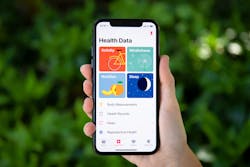Via a new operating system update from Apple slated for later this year, iPhone users will be able to privately share their health data with a trusted partner or caregiver, the tech giant revealed on June 7.
The announcement was part of a slew of updates Apple gave on its iPhone, Apple Watch and AirPods products as part of its annual Worldwide Developers Conference.
Apple’s iOS 15 software update is scheduled to come out this fall and will give users the ability, if they choose, to “give a loved one visibility into their health and wellness data, enabling them to have more meaningful conversations and provide support— even from afar—as they follow important alerts and changes over time,” Apple officials stated.
More specifically, Apple’s already existing Health app will include a new “Sharing” tab that lets users privately share their data with a trusted partner or caregiver. Users have full control over which data they share and with whom, whether they’re an aging parent who shares their activity or heart health data with a family member, a partner who chooses to share their fertility window insights, or a person with Parkinson’s disease who wants to share their mobility data with a physical therapist, Apple offered.
With user permission, the Health app can keep track of valuable information, potentially bridging the gap of what a person experiences between clinic appointments. U.S. users, through this feature, can choose to share certain types of health data—such as heart rate, detected falls, hours of sleep, or exercise minutes—with their doctor, which could lead to more informed conversations.
At participating healthcare organizations, a physician can review the Apple Health app data that a user chooses to share directly in the electronic health records (EHR) system, officials explained. According to a Fierce Healthcare report that covered Apple’s event yesterday, during the presentation, “Apple listed Cerner, Allscripts, athenahealth, CPSI, DrChrono and Meditech Expanse as the first vendors that will support this type of data sharing.”
In an emailed statement, athenahealth company leaders said they are “proud to support an upcoming feature allowing patients to share data from the Apple Health app on their iPhone with their provider, for more informed conversations. Streamlining information sharing in this way empowers patients as a critical part of their care team, securely provides clinicians with data that helps them see a more complete picture of the patient’s health, and supports our goal to help all people lead healthier lives.”
iPhone owners already had the ability to access their health data via Apple’s Health Records platform that launched early in 2018 and is now live at hundreds of hospitals and clinics. Health Records allows patients who visit participating providers to access their health data on the iPhone Health app, and now, more features, such as data sharing, will be added to the Health Records tool.
For the person receiving this information, shared data is presented with important insights and trends highlighted, officials noted. Indeed, the new “Trends” feature as part of the Health app—also part of the software update—will add analysis for 20 types of data — ranging from resting heart rate to sleep to cardio fitness — so users can see how a given metric is progressing.
Apple officials believe that for users looking to keep an eye on their data over time, “Trends is a new way to intelligently and proactively highlight important changes, and surfaces the information in a way that’s easy to understand.” For those looking to monitor insights across areas like insulin delivery, trend analysis applies to data from third-party devices connected to the Health app.
“This past year has emphasized the importance of health, and we’re enabling our users to take a more active role in their well-being. We’ve added powerful features that give users the most comprehensive set of insights to better understand their health trends over time,” said Jeff Williams, Apple’s chief operating officer. “Many people around the world are caring for someone, and we want to provide a secure and private way for users to have a trusted partner on their health journey. We’re excited to bring these innovative tools directly into users’ hands.”
Touching on the important privacy conversation that is often brought up when a patient’s health information moves—especially via an app—Apple stated that “Health data is under a user’s control, with granular control over which data types they choose to share and with whom. Data is encrypted when in transit and while at rest on a user’s device when locked behind a passcode, Face ID, or Touch ID. Apple does not have access to this information when a user chooses to share it with a loved one or doctor.”
Additional Health Records functionality
More features will also be added to Apple’s Health Records platform, which debuted over three years ago. In its June 7 release, Apple announced that an “enhanced labs experience” comes to Health Records on iPhone, making it easier for users to review their results. Users can view highlights, pin results that may matter most to them, see whether labs are within range, and, for those in the U.S., access educational content about common lab tests, officials said.
What’s more, in iOS 15, users worldwide will have an additional option for storing medical records of immunizations and test results directly in the Health app. Now, even if a vaccine provider or medical location doesn’t currently support the Health Records feature, it can allow patients to download verifiable COVID-19 vaccination or test result records from an online browser or QR code, so they can easily access them at any time, officials noted.
The news of this latest functionality comes a few months after STAT reported that Google has launched an early user feedback program aimed at exploring how patients might want to see, organize, and share their own medical record data.
To that end, on the Android side, The Commons Project’s CommonHealth app is designed to allow users of the Android operating system to collect and manage their health data on their mobile devices in a similar way that Apple Health Record operates on iOS. In December, leaders of that initiative announced that the CommonHealth app has connected to 230 health systems in the U.S., allowing patients using those health systems to gather, manage and share personal health information. CommonHealth also just recently went live with its SMART Health Cards, which are paper or digital versions of a patient’s clinical information, such as vaccination history or test results. They allow individuals to keep a copy of records on hand and share this information with others if they choose.
These efforts are becoming more important as new federal data-sharing rules will soon require EHR vendors to build APIs so that patients can access and transfer their health data to mobile apps of their choice. Hospitals and physician offices will also have to send standardized medical information, such as lab test results, vaccination records and imaging tests, directly to third-party apps.
About a year after its launch, the first research on Apple’s Health Records initiative, conducted by the University of California San Diego Health, revealed that patients are generally satisfied with the app’s ease-of-use and feel that it improves their understanding of their health and has facilitated conversations with clinicians. A separate review from KLAS Research found that many CIOs, CMIOs, chief medical officers and other clinical IT executives viewed the concept of accessing personal medical records on smartphones as “a revolutionary idea.” Three of the most mentioned benefits in that report included empowering patients, helping solve interoperability, and speeding innovation and change.
Meanwhile, Apple also introduced a new “Walking Steadiness” feature for its iPhone, which provides insight into fall risk by capturing important mobility data as users walk with their iPhone. Currently, fall risk is assessed by a care provider through a questionnaire and an in-person evaluation. Walking Steadiness offers the added ability to capture everyday movements and surface classifications within the Health app as “OK,” “Low,” or “Very Low,” allowing users to proactively take action to help reduce their risk of falling, officials explained.
Walking Steadiness uses custom algorithms to assess balance, stability, and coordination through built-in motion sensors on iPhone. This metric was established using real-world data from the Apple Heart and Movement Study, with more than 100,000 participants across all ages—the largest data set ever used to study fall risk, Apple stated.


